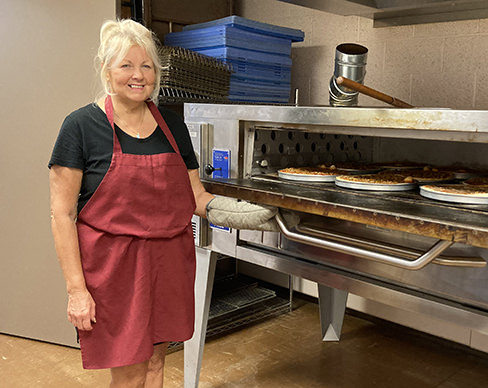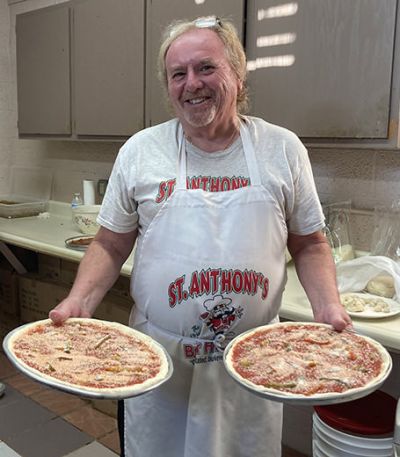by The Business Journal, Youngstown, Ohio
The aroma of fresh-baked dough, tomato sauce and Italian spices wafts from the St. Anthony of Padua Church in Youngstown on Saturday mornings from September to June.
Twenty to 30 volunteers gather inside to make the Brier Hill pizzas they sell to raise money for the church, which is in the North Side neighborhood that gave the pizza its name.
For those who may not know, Brier Hill Pizza consists of a secret sauce dotted with sweet red and green bell peppers, slathered on a pizza shell and sprinkled with Romano cheese – never mozzarella.
“Really, what makes it special is how the Italian ladies would make it for their families,” says Ernie DiRenzo of McDonald, who’s run the church’s pizza-making operation since 2016. Bill Lawson, executive director of the Mahoning Valley Historical Society, says the local pizza favorite made its way to the Youngstown region via Italian immigrants who settled in the area. “They brought their pizza recipe with them with the grated cheese and the sauce and everything that goes into the sauce,” he says. “We have a very discerning pizza palate around here, to say the least.”
People who emigrated from Italy often worked in the steel mills. “People from Italy also brought their building trade skills with them,” Lawson says. “They were bricklayers and masons. They worked in the construction trades.” Some of the immigrants landed in Youngstown on their own, but companies also sent recruiters to Europe, particularly Italy, looking for workers.
The Brier Hill neighborhood is so named because it was the site of Brier Hill Farm, owned by George Tod in the early 1800s. Part of that land became Tod Homestead Cemetery. George Tod, who was a judge, was the father of David Tod, Ohio governor from 1862 to 1864. The Tod family also started the first iron furnace in that neighborhood. It later became the Brier Hill Works of Youngstown Sheet & Tube.
Traditionally, the neighborhood’s many Italian families grew tomatoes and bell peppers in their gardens. Other ingredients were pantry staples, making the specialty pizza an inexpensive family meal. “Ours is unique,” DiRenzo says. “No one else’s tastes like ours.” The sauce is the church’s recipe and DiRenzo won’t share it.
The church’s pizza fundraiser began in 1972. DiRenzo arrives at about 4 a.m. to prepare for the day and to make the dough while another volunteer makes the sauce. At about 6 a.m., a group of women join the effort to portion out the dough. The rest of the crew – those who roll out the dough, add the sauce, peppers and cheese and place them in the ovens – arrives at about 7 a.m.
Customers start arriving at about 9 a.m. to pick up their pre-ordered pizzas. DiRenzo takes orders on his cell phone for the upcoming Saturday from Wednesday through Friday. The number to order pizzas is 330-360-7663. One recent Saturday, volunteers made and sold 230 pizzas, but the number varies each week.
Pizza sales comprise St. Anthony’s largest fundraiser. Each regular 12-inch pizza costs $8. Those with additional toppings such as sausage or hot peppers, and specialty pizzas, including egg and garlic, cost a bit more.
While they shut down for the summer, the volunteers sell their pizzas during the annual Brier Hill Festival in August. This year they sold 1,400 pizzas during that four-day event. “We sold out within a couple hours each day,” DiRenzo says. “If we had more help, we probably could have made more pizzas all day long. Sunday, the last day, we made just under 400 pizzas. They opened up at 1 o’clock and just before 3 we were sold out.”
While church volunteers pride themselves on their pizza, believing it’s the best around, many Mahoning Valley pizzerias and restaurants list their own Brier Hill pizzas on their menus.
Brier Hill pizza is one of the most popular pizzas at Avalon Downtown Pizzeria. “It’s right up there with our traditional,” says owner Anne Massullo Sabella. She believes it’s popular because it adheres to the customary recipe. “It’s probably because we still make that style of pizza the way the immigrants who settled in the area made it,” she says. Avalon hand sheets the pizza dough, meaning they hand press it into the pans rather than using a machine. They also use high-quality ingredients, Sabella says. “The tomatoes and the peppers were canned from their [immigrant families’] garden,” she says. Customers often tell Sabella that Avalon makes the best Brier Hill pizza. “I hear that it tastes like their grandmother’s or their mother’s or their aunt’s,” Sabella says. “I think it brings back nostalgia for people.”
At Pizza Joe’s, which has locations all over northeastern Ohio and western Pennsylvania as well as other parts of the country, they call it homestyle pizza. That’s because the Brier Hill pizza name coincides with the Youngstown neighborhood and isn’t familiar to customers outside of the area.
Pizza Joe’s version follows a similar formula though. “Pizza Joe [Seminara] grew up eating it, as did most Italian immigrant families,” says Katie DeToro, referring to her father, who started the pizza shop chain. His mother made it for the family, growing the tomatoes in her garden. She used fresh garlic and hand-grated Romano cheese, DeToro says. Even if mozzarella cheese were available, many families couldn’t afford it. Seminara put the homestyle pizza on the restaurant’s menu in the early 1980s. “It’s lasted a span of more than 40 years,” she says. The restaurant’s homestyle pizza includes a sweeter sauce, which DeToro says sets it apart from other pizzas. If they add peppers, they use Papa Canzonetta’s Peppers, developed by Jeff Canzonetta of Hubbard. “It’s a great combination,” DeToro says. Pizza Joe’s homestyle pizza is more popular at the Mahoning Valley and New Castle stores than locations in other cities, she says. “In Youngstown, it’s extremely popular,” DeToro says.
At St. Anthony’s, Marlene Jurek of Struthers started volunteering to help with the pizza making several years ago, recruited by a friend. “I enjoy it,” she says. “Everybody is really nice here. You’re out of here generally by noon so it’s from 7 to noon. I’d just be sleeping then. You get a good feeling that you’re giving back.”
Roy Oliver of Struthers started helping with the pizzas when he was 17. His great-grandmother and great-aunts were involved in the early years, and it became a tradition for him too. Oliver’s daughters sometimes pitch in at the pizza making as well. “It’s in my blood,” Oliver says as he works the ovens to make sure each pie meets the Brier Hill standards before he takes it out. “I take pride in my work.”

Marlene Jurek of Struthers shows just a few of the Brier Hill pizzas being baked for a recent Saturday sale.



